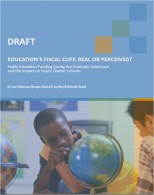 In our 2005 report, Charter School Funding: Inequity’s Next Frontier, we wrote, “U.S. charter schools are being starved of needed funds in almost every community and state.” We backed that statement with funding data from seventeen states and twenty-seven districts. A 2010 report, tracking 2006–07 data, agreed. In the years since, some jurisdictions have moved to provide more equal funding levels to district and charter schools, yet large disparities remain. This paper—which will be published in the Journal of School Choice in September—examines the extent of those inequalities. Larry Maloney and colleagues tallied local, state, federal, and non-public revenue from 2007 to 2011 in Denver, Newark, Los Angeles, Washington, D.C., and Milwaukee. The upshot: On average in 2011, charters received $4,000 less per pupil, per year, across all five studied locales, with gaps ranging from $2,700 in Denver to nearly $13,000 in D.C.—though jurisdictions with the largest spending gaps (Newark and D.C., specifically) actually narrowed the gap between district and charter funding during the study period while those that started out closer to equal funding widened the gap. The authors also noted that charter schools—which receive a higher percentage of their operating budget from nonpublic revenue, such as foundation grants—were hit harder by the economic recession than their district counterparts: While states seemed to find funds (sometimes federal bailout dollars) to shelter district schools during the worst of the recent economic storm, charter schools, and their students, were often left out in the cold.
In our 2005 report, Charter School Funding: Inequity’s Next Frontier, we wrote, “U.S. charter schools are being starved of needed funds in almost every community and state.” We backed that statement with funding data from seventeen states and twenty-seven districts. A 2010 report, tracking 2006–07 data, agreed. In the years since, some jurisdictions have moved to provide more equal funding levels to district and charter schools, yet large disparities remain. This paper—which will be published in the Journal of School Choice in September—examines the extent of those inequalities. Larry Maloney and colleagues tallied local, state, federal, and non-public revenue from 2007 to 2011 in Denver, Newark, Los Angeles, Washington, D.C., and Milwaukee. The upshot: On average in 2011, charters received $4,000 less per pupil, per year, across all five studied locales, with gaps ranging from $2,700 in Denver to nearly $13,000 in D.C.—though jurisdictions with the largest spending gaps (Newark and D.C., specifically) actually narrowed the gap between district and charter funding during the study period while those that started out closer to equal funding widened the gap. The authors also noted that charter schools—which receive a higher percentage of their operating budget from nonpublic revenue, such as foundation grants—were hit harder by the economic recession than their district counterparts: While states seemed to find funds (sometimes federal bailout dollars) to shelter district schools during the worst of the recent economic storm, charter schools, and their students, were often left out in the cold.
SOURCE: Larry Maloney, Meagan Batdorff, Jay May, and Michelle Terrell, Education’s Fiscal Cliff, Real or Perceived? (University of Arkansas Department of Education Reform, April 2013).

